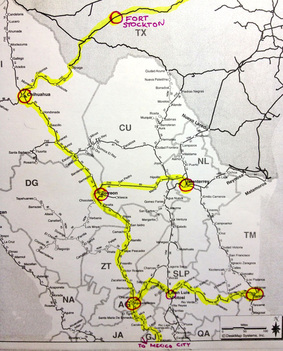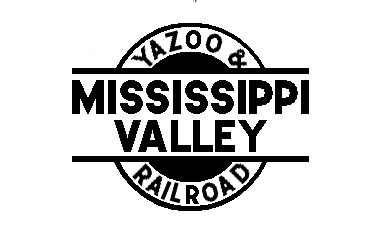The NT&O/T&GN Story - 4
The Mexico Connection
My inspiration for incorporating The Mexico Connection into the business plan for the NT&O was much first-hand experience south of the border. I have made a number of trips with Lowell McManus, Nick Huth, and/or Dan Munson to view, ride, and photograph trains. It has struck me as odd how poorly the Mexican rail network is integrated with the US rail network. Below is the story of the Mexico Connection for the Meridian Speedway.
(The Below Story is Fiction)

Part of the business plan presented to Georgia Pacific senior leadership was an aggressive agenda to capture a large portion of freight traffic traveling between Eastern and Southern U.S. markets and Mexico. There was a four-point strategy to accomplish this:
1 – Act quickly on the newly created opportunity to privatize railroads in Mexico. The subsidiary Chihuahua Rio Fuerte y Pacifico was formed and the primary routes highlighted in yellow on the map were secured with a 50-year operating concession from the Government of Mexico.
2 - Upgrade the core routes of the Meridian Speedway to handle traffic at a rate that would allow competition with other routes.
3 - Build a hump yard at Fort Stockton, TX that would serve as the primary point of classification for manifest traffic in the Mexico network.
4 - Work outside the Meridian Speedway network to develop primary long-distance routes. This would include direct service from Fort Stockton to terminals on other US Class I railroads as well as coordination with Mexican counterparts to provide competitive service to the interior of Mexico.
The primary NT&O connection with Mexico is at Ojinaga, Chihuahua which is adjacent to Presidio, TX. West from Ojinaga the railroad runs west through Chihuahua to Topolobampo, Sinaloa on the Gulf of California--the shortest route to Pacific Waters from the U.S. East coast. Most of the traffic is diverted south at Chihuahua, Chihuahua to other Mexican destinations. The route to Topolobampo never achieved the significance that Rail Baron Arthur Stilwell dreamed of because of the tight curves and steep grades southwest of Creel, Chihuahua that greatly restrict train length and speed.
A manifest plan was designed for the hump yard at Fort Stockton, TX to classify cars for nine trains a day into Mexico, or three builds/departures per shift. The Mexico blocks sorted at Fort Stockton are Saltillo, Chihuahua, Torreon, Monterrey, Tampico, Aquascalientes, Mexico City Empties, Mexico City Loads, and Mexico City South (to Ferrosur). Trains could be comboed, annulled, or extras called on a daily basis. These decisions would be made at the Superintendent level. For example, the Torreon and Saltillo blocks could ride the train to Monterrey or the Aquascalientes and San Luis Potosi blocks could ride the train to Tampico. The three Mexico City blocks could be consolidated into one train as well. The marketing department, however, has made a commitment to fill these trains up…and they will.
The off-line U.S. destinations for trains built at Fort Stockton include Galesburg, IL; Kansas City, KS, Atlanta, GA, Brimingham, AL, Waycross, GA: Irving, TX; and Chicago, IL; among others. Visit the Manifest Mexico Train Symbol page for more information on trains handled at Fort Stockton.
To increase the fluidity of the Mexico manifest network, 100 Mexican locomotives were improved with FRA Type II Window Glazing and other features to allow them to lead trains in the U.S. In addition, 100 NT&O locomotives would be placed in this pool to operate through from Fort Stockton to destinations in Mexico. This meant that the only delay at the border would be for customs inspection and crew change. Most of the Mexican locomotives would be turned back to Mexico from Fort Stockton; but, as operational challenges dictated, the locomotives could operate east from Fort Stockton to other U.S. destinations.
In addition to the manifest network, the NT&O would develop markets in Mexico for Eastern U.S coal. The timing proved excellent as Eastern U.S. coal consumers were converting to Powder River Basin coal for environmental reasons. Auto Parts Trains, Vehicle Trains, Export Grain Trains, and Intermodal Trains also operate into Mexico via the Presidio/Ojinaga border crossing. These trains would just run through Fort Stockton.
A locomotive shop would also be located in Fort Stockton to support the fleet of locomotives assigned to this service. These units, primarily SD70Ms, will have Fort Stockton labeled on them.
1 – Act quickly on the newly created opportunity to privatize railroads in Mexico. The subsidiary Chihuahua Rio Fuerte y Pacifico was formed and the primary routes highlighted in yellow on the map were secured with a 50-year operating concession from the Government of Mexico.
2 - Upgrade the core routes of the Meridian Speedway to handle traffic at a rate that would allow competition with other routes.
3 - Build a hump yard at Fort Stockton, TX that would serve as the primary point of classification for manifest traffic in the Mexico network.
4 - Work outside the Meridian Speedway network to develop primary long-distance routes. This would include direct service from Fort Stockton to terminals on other US Class I railroads as well as coordination with Mexican counterparts to provide competitive service to the interior of Mexico.
The primary NT&O connection with Mexico is at Ojinaga, Chihuahua which is adjacent to Presidio, TX. West from Ojinaga the railroad runs west through Chihuahua to Topolobampo, Sinaloa on the Gulf of California--the shortest route to Pacific Waters from the U.S. East coast. Most of the traffic is diverted south at Chihuahua, Chihuahua to other Mexican destinations. The route to Topolobampo never achieved the significance that Rail Baron Arthur Stilwell dreamed of because of the tight curves and steep grades southwest of Creel, Chihuahua that greatly restrict train length and speed.
A manifest plan was designed for the hump yard at Fort Stockton, TX to classify cars for nine trains a day into Mexico, or three builds/departures per shift. The Mexico blocks sorted at Fort Stockton are Saltillo, Chihuahua, Torreon, Monterrey, Tampico, Aquascalientes, Mexico City Empties, Mexico City Loads, and Mexico City South (to Ferrosur). Trains could be comboed, annulled, or extras called on a daily basis. These decisions would be made at the Superintendent level. For example, the Torreon and Saltillo blocks could ride the train to Monterrey or the Aquascalientes and San Luis Potosi blocks could ride the train to Tampico. The three Mexico City blocks could be consolidated into one train as well. The marketing department, however, has made a commitment to fill these trains up…and they will.
The off-line U.S. destinations for trains built at Fort Stockton include Galesburg, IL; Kansas City, KS, Atlanta, GA, Brimingham, AL, Waycross, GA: Irving, TX; and Chicago, IL; among others. Visit the Manifest Mexico Train Symbol page for more information on trains handled at Fort Stockton.
To increase the fluidity of the Mexico manifest network, 100 Mexican locomotives were improved with FRA Type II Window Glazing and other features to allow them to lead trains in the U.S. In addition, 100 NT&O locomotives would be placed in this pool to operate through from Fort Stockton to destinations in Mexico. This meant that the only delay at the border would be for customs inspection and crew change. Most of the Mexican locomotives would be turned back to Mexico from Fort Stockton; but, as operational challenges dictated, the locomotives could operate east from Fort Stockton to other U.S. destinations.
In addition to the manifest network, the NT&O would develop markets in Mexico for Eastern U.S coal. The timing proved excellent as Eastern U.S. coal consumers were converting to Powder River Basin coal for environmental reasons. Auto Parts Trains, Vehicle Trains, Export Grain Trains, and Intermodal Trains also operate into Mexico via the Presidio/Ojinaga border crossing. These trains would just run through Fort Stockton.
A locomotive shop would also be located in Fort Stockton to support the fleet of locomotives assigned to this service. These units, primarily SD70Ms, will have Fort Stockton labeled on them.
Page 4



